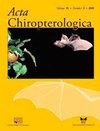扁头蝙蝠扁平肌炎的颅骨形态与美国肌炎的关系
IF 0.7
4区 生物学
Q4 ZOOLOGY
引用次数: 0
摘要
扁平肌炎是一种食虫物种,在肌炎物种中具有独特的平头形态。它的分布仅限于墨西哥东北部的高地,并使用肉苁蓉树栖息。该物种特殊的生态和形态特征使其可能成为资源利用专家。我们使用几何形态计量方案和多变量统计分析,与属于不同饮食类别的13种美国同类相比,评估了扁平M.planiceps的形态特化。我们估计了不同饮食类别的形态差异,包括作为一个单独的组的扁平M.planiceps,并评估了颅骨大小和饮食对颅骨形态变化的影响。我们发现该物种在所有的头骨形状特征上都有显著的差异,软食虫动物是最接近平原M.planiceps的饮食群体。此外,饮食解释了颅骨和下颌骨形状变化的相似百分比,并且饮食和颅骨大小之间的最高相互作用记录在脑壳中。一般来说,在软体食虫动物身上观察到最小的尺寸和较薄的头骨。我们的发现并不支持第一主成分描述的头骨形状特征与食物硬度之间的显著关系,但我们发现与下颌骨形状有显著关联。在这些模型的残差方差中没有观察到系统发育结构。我们发现,头骨形态的变化趋势与特殊的栖息地有关,渔蝙蝠M.vivesi的下颌特征更具对比性,而M.planiceps的脑壳形态更具对比度,后者生活在有限的栖息地,可能以软体昆虫为食。本文章由计算机程序翻译,如有差异,请以英文原文为准。
Cranial Morphology of the Flat-Headed Bat Myotis planiceps (Chiroptera: Vespertilionidae) in the Context of American Myotis
Myotis planiceps is an insectivorous species with a distinctive flat-headed morphology among Myotis species. Its distribution is restricted to the northeastern Mexico highlands, and uses trees of Yucca carnerosana to roost. The particular ecological and morphological characteristics of this species make it a likely resource-use specialist. We evaluated the morphological specialization of M. planiceps as compared with thirteen American congeners belonging to different dietary categories, using a geometric morphometric protocol and multivariate statistical analyses. We estimated morphological differences across dietary categories, including M. planiceps as a separate group, and evaluated the effect of cranial size and diet on variations in cranial morphology. We found a significant differentiation of this species in all the cranial shape characters, with soft insectivores as the dietary group closest to M. planiceps. Additionally, diet explained similar percentages of shape variance in cranial and mandibular characters, and the highest interaction between diet and cranial size was recorded in the braincase. In general, the smallest sizes and thinner skulls were observed in soft insectivores. Our findings do not support a significant relationship between skull shape characters, described by the first principal component, and hardness of food items, but we found a significant association with the mandible shape. No phylogenetic structure was observed in the residual variance of these models. We found trends of change in cranial morphology associated with specialized habitats, the mandibular characters being more contrasting in the fishing bat M. vivesi, and the braincase morphology being more contrasting in M. planiceps, a species that lives in restricted habitats and probably feeds on soft insects.
求助全文
通过发布文献求助,成功后即可免费获取论文全文。
去求助
来源期刊

Acta Chiropterologica
生物-动物学
CiteScore
2.50
自引率
20.00%
发文量
42
审稿时长
>12 weeks
期刊介绍:
Acta Chiropterologica, published by the Museum and Institute of Zoology at the Polish Academy of Sciences, is devoted solely to the study and discussion of bats.
 求助内容:
求助内容: 应助结果提醒方式:
应助结果提醒方式:


